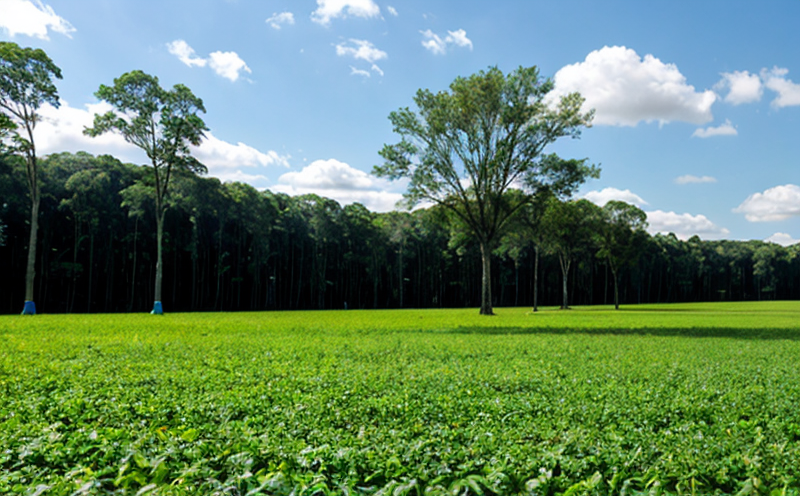Aquatic Biodegradability Testing of Product Residues
Understanding and ensuring the environmental impact of consumer products is crucial in today’s sustainability-driven market. Aquatic biodegradability testing evaluates whether product residues can be broken down by microorganisms into harmless compounds, thus minimizing their environmental footprint. This service is particularly important for companies that produce plastics, coatings, textiles, or any other material that could end up in water bodies.
The process of aquatic biodegradability testing involves several critical steps. Initially, the product residues are prepared according to specific protocols established by international standards such as ISO 14855-2. The specimens undergo incubation periods within controlled laboratory environments where various parameters like temperature and pH levels mimic natural conditions.
Microbial cultures specific to aquatic environments are then introduced into these samples, allowing for the assessment of biodegradation rates over time. Various indicators such as carbon dioxide production or weight loss are monitored throughout this process to determine if the tested material can effectively degrade under realistic conditions.
This service not only aids in regulatory compliance but also helps businesses make informed decisions about product design and formulation. By identifying non-biodegradable components early on, manufacturers can reduce costs associated with waste management while enhancing their public image through eco-friendly practices.
For instance, a company developing a new line of packaging materials might use this service to verify that any residual adhesives or inks used are fully biodegradable. Similarly, textile firms could apply it when introducing innovative fabric finishes intended for outdoor wear.
The importance of accurate testing cannot be overstated; incorrect assumptions about a product’s environmental behavior can lead to significant financial losses and reputational damage. Our lab employs state-of-the-art facilities equipped with advanced instrumentation capable of providing precise measurements necessary for reliable results.
Moreover, we adhere strictly to internationally recognized guidelines ensuring consistency across different regions. This commitment to quality control guarantees that every test conducted aligns perfectly with global standards such as ISO 14855-2 or ASTM D6954.
In summary, aquatic biodegradability testing plays an indispensable role in safeguarding our environment by providing essential insights into the lifecycle of consumer products. It enables businesses to contribute positively towards sustainability goals without compromising on performance or innovation.
Scope and Methodology
| Parameter | Description |
|---|---|
| Sample Preparation | Follows ISO 14855-2 guidelines for preparing product residues. |
| Inoculation Conditions | Incubation at specified temperature and pH levels. |
| Microbial Cultures | Aquatic-specific microbial strains used to promote degradation. |
| Monitoring Indicators | CO₂ production, weight loss, etc., measured over time. |
The scope encompasses the entire lifecycle of a product from raw material selection through manufacturing and disposal. Our methodology ensures that all aspects are considered when assessing biodegradability. From initial sample preparation to final analysis, each step is meticulously documented using advanced analytical techniques designed specifically for this purpose.
Our approach also includes pre-test consultations with clients to tailor the testing process according to their unique requirements. By doing so, we provide customized solutions that meet both regulatory expectations and business objectives effectively.
Industry Applications
- Plastic manufacturers evaluating biodegradable additives for packaging films.
- Cosmetics companies ensuring their surfactants break down safely in aquatic environments.
- Fashion brands testing fabric treatments to ensure they do not persistently pollute waterways.
- Paper producers assessing the degradability of coatings used on cardboard boxes.
| Application Area | Benefits |
|---|---|
| Regulatory Compliance | Avoid fines and penalties for non-compliance with environmental regulations. |
| Innovation | Promote sustainable practices that enhance brand reputation. |
| Risk Management | Identify potential risks early in the product lifecycle, reducing long-term expenses. |
| Market Differentiation | Capture niche markets seeking environmentally responsible products. |
The applications are vast and varied across multiple sectors. This service is applicable not just to consumer goods but also extends to industries like pharmaceuticals, agriculture, and electronics where residues could potentially end up in water bodies.
International Acceptance and Recognition
Aquatic biodegradability testing has gained widespread acceptance globally due to its crucial role in environmental protection. Many countries have incorporated this practice into their national legislation, mandating it for specific types of products or materials.
For example, the European Union's Directive 1999/44/EC requires certain biodegradable plastics to undergo such testing before entering commerce. Similarly, China’s GB/T 20876-2007 standard provides detailed procedures for conducting these tests on various materials.
Our laboratory follows all relevant international standards including ISO 14855-2 and ASTM D6954 to ensure our results are universally accepted. By aligning ourselves with these benchmarks, we guarantee that the information provided is reliable and can be used confidently by stakeholders worldwide.





